Combat sport
![]()
The articles martial arts and combat sports overlap thematically. Information that you are looking for here can also be found in the other article.
You are welcome to participate in the relevant redundancy discussion or directly help to merge the articles or to better distinguish them from each other (→ instructions).
![]()
This article or subsequent section is not sufficiently supported by evidence (e.g., anecdotal evidence). Information without sufficient evidence may be removed in the near future. Please help Wikipedia by researching the information and adding good supporting evidence.
In the German-speaking world, martial arts is the collective term used in public (outside specialist circles) for the many different fighting styles, especially those that do not involve the use of firearms. The term is particularly often associated with the Asian tradition of Japanese Budō, Chinese Kung Fu (actually Wushu) or Korean Taekwondo. The martial arts best known in Europe include boxing, karate, judo, wrestling, aikido, as well as locally important sports such as Swiss swinging, Russian sambo or Turkish oil wrestling.
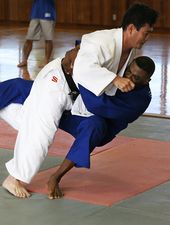
Judo
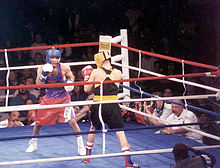
Boxing
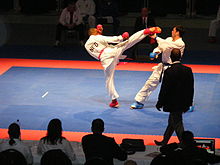
Karate
Martial arts and combat sports
In professional circles, a more precise differentiation between martial arts and combat sports is usually used. In martial arts, the focus is on regulated sporting competition in which the aim is to win within the framework of the rules and to be better than the opponent. In most martial arts, weapons are not used and if they are, then only sporting weapons that reduce the risk of injury or prevent it from occurring in the first place. Competitions in martial arts are usually duels, but other forms of competition are possible.
A martial art, on the other hand, is usually concerned with self-defense and behavior in real, unregulated situations of danger or conflict. Therefore, every martial art contains fighting techniques that have the goal of defeating an opponent, often also with the use of weapons. In addition, a martial art often includes other aspects, such as avoiding conflict in advance, generally increasing agility, strength, speed, or self-discipline. Some martial arts systems, especially from the Asian environment, see themselves as a complete system of life design or perfection with a corresponding philosophical or religious underpinning, such as the Japanese Budō. Especially nowadays, the actual fighting techniques sometimes even take a back seat or are only understood as a way to the actual goal. Competitions in the martial arts are usually not duels.
The distinction between martial arts and combat sports is not sharp. Of many martial arts there are also variants that allow the sporting duel (eg karate). In other martial arts, however, sporting individual competitions are in the foreground (e.g. in modern Wushu), while the aspect of self-defence and real combat recedes into the background.
Ralf Pfeifer proposes in his book "Mechanics and Structure of Martial Arts - Manual for Trainers in Martial Arts and Combat Sports" the following (not undisputed) criteria of distinction.
| Martial Arts | Martial Arts |
| Supreme principle: "Everything is allowed, there are no rules", successful SV techniques do not have to be adapted to any set of rules. | The highest principle: "The sports fighters must not suffer any permanent damage". The sport fight should also be fun. |
| The fight begins and continues until one of the opponents surrenders (or is unable to do so) or withdraws from the fight. | The fight is decided by a third party (referee). It is more important to convince the referee of one's own abilities than to defeat the opponent. Secret fouls are therefore often used as a tool for victory. |
| The opponent is always right if the technique he used was successful. | The opponent can commit rules violations and can be disqualified afterwards despite a victory. |
| If one of the fighters is superior, he will use this superiority and continue to fight until victory. | In some martial arts, if one of the fighters gets into a superior position, the fight is stopped and the fighters are allowed to resume an equal starting position. |
| The fight is ended swiftly, there is no second chance. | The fight is artificially prolonged, everyone gets a new chance again and again. Who looked bad at the beginning, can still be the winner afterwards. |
| If the victim gives up, they still face further attacks, especially if the attack is part of a crime. | If a fighter retires, the referee will ensure the end of the bout and the safe retreat of the losing fighter. Striking or kicking after the referee has intervened will be penalised. |
| The technique program does not only include expedient SV techniques, but the defense against attacks that are frequently and successfully used in sports fighting styles must be practiced, since one cannot choose one's opponent. | The technique program is rule-oriented. Only that is practiced, which also brings success in the sport fight. It is not necessary to practice other techniques, because the opponent and the rules are known to the fighter beforehand. |
| Neither opponent nor venue is known. It is not possible to work out an individual strategy or technique for a specific opponent. | The opponent and venue of the fight is known weeks or months in advance. It is therefore possible to work out individual strategies and techniques for each opponent, which are allowed within the respective set of rules. |
Competitions
In martial arts, there are two main types of competitions: duels and formal competitions.
Duels
In a sporting duel, one, or in rare cases several, opponents must be defeated. Depending on the sport, very different criteria can lead to victory:
- knocked out (e.g. boxing)
- Precipitation
- successful application of certain techniques (e.g. in karate)
- Immobilization of the opponent (e.g. in Judo)
- throwing the opponent out of the ring (e.g. in sumo wrestling)
- Forcing the opponent to give up, for example in Judo.
- Ground contact of certain body parts (e.g. both shoulders when wrestling, swinging)
As a rule, certain techniques are forbidden, such as stabs to the eyes, blows to the genital area, or kicks, throws or leverage techniques in general, and are not part of the training program of the sport.
The flow of the duel can also be highly regimented. In certain forms of kumite in karate, for example, each opponent is allowed to perform a fixed number of attacks that the other opponent must successfully fend off in order to win.
Form competitions
In many Far Eastern martial arts and sports, the most frequent and sometimes only competitions are so-called form competitions. The martial artists perform rehearsed movements (e.g. Kata in the Japanese martial arts (Budō) or Taolu in the Chinese martial arts (Wushu)), which are then evaluated by judges. These can be fixed or self-devised forms, with very different durations and numbers of movements, which are performed individually or in groups, synchronously or as a choreographed fight.
As in other sports, various criteria are used in the evaluation, such as the difficulty of the form, the accuracy of the execution of the various movements, expression, etc.
If competitions exist at all in the martial arts, they are form competitions.
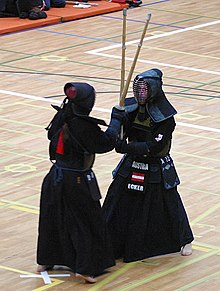
Kendō (EM 2005)
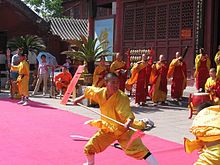
Demonstration of a form of Shaolin martial arts at the Daxiangguo Monastery in Kaifeng, Henan, PR China
Search within the encyclopedia